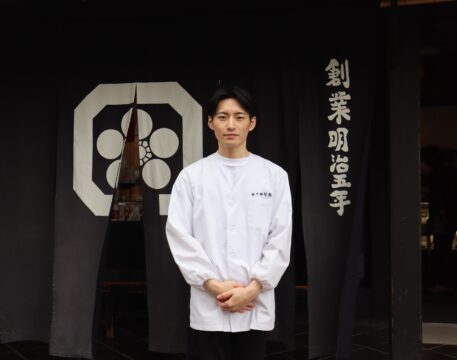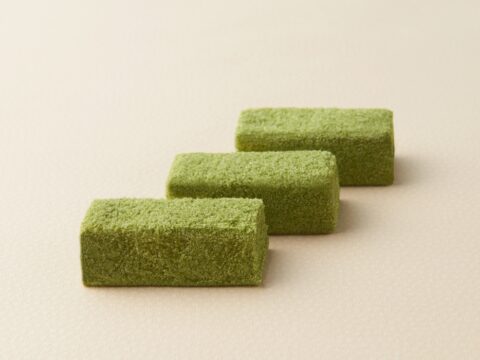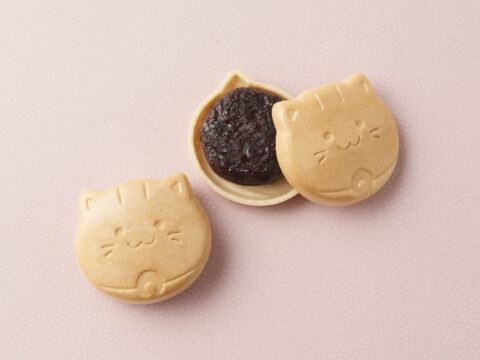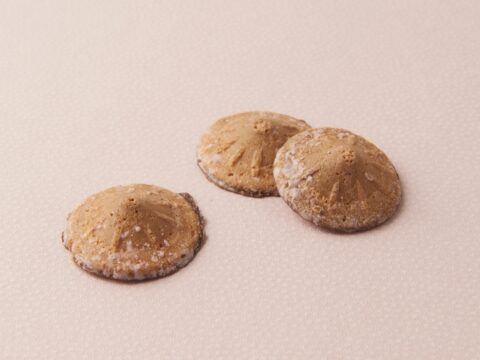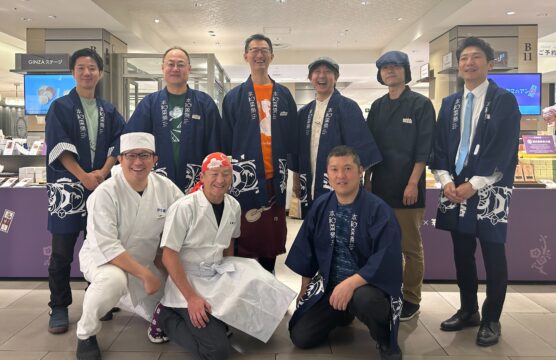
More free and honest. A new Japanese confectionery that combines the origins of Japanese confectionery with the essence of the modern era.
"The 12th Honwa-kashu 12 ~Free Sensibility and Inherited Skills~"
■Period: November 27, 2024 (Wednesday) to December 3, 2024 (Tuesday)
■ Venue: Ginza Mitsukoshi Main Building B2F GINZA Stage ※Mitsukoshi Isetan food media website "FOODIE" URL: https://mi-journey.jp/foodie/100051/
Ginza Mitsukoshi will be holding the "12th Honwakashū 12 ~Free Sensibility and Inherited Skills~" event at the GINZA Stage on the second basement floor of the main building from November 27th (Wed) to December 3rd (Tue). This will be the 12th time the event has been held at Ginza Mitsukoshi, and the aim is to go back to the origins of Japanese sweets and be more free and honest. They have come up with new Japanese sweets that are not bound by traditional methods, ingredients, or shapes. This time, eight brands will gather at the venue. Keep an eye out for the sweets that will be appearing at the venue for the first time.
<Mase Confectionery Shop> Going beyond the boundaries of high-quality fresh confections, elevating individuality with a "free" idea
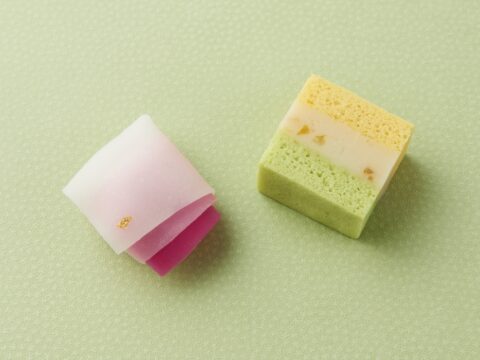
<Mase Confectionery Shop> Freely Picked (2 pieces/2 types, 1 piece each) 1,080 yen *Limited to 350 pieces
Mase Confectionery, which is participating in Honwa Kashu for the first time, is a long-established confectionery shop that has been in business in Atami since the 5th year of the Meiji era. The number "12" is reminiscent of the twelve-layered ceremonial kimono. They have created two types of confectionery.
◆The buyer in charge speaks◆
The first, "Kurenai" (pictured left), is a high-grade fresh confectionery made of raspberry puree wrapped in bean paste made from fresh cream and condensed milk, then rolled up in thinly rolled uiro dough. It has a good balance of sourness and richness. The other, "Yugasane" (pictured right), is made by pouring yokan made with chopped yuzu and cream cheese over yuzu-scented ukishima dough. As it uses dairy products such as fresh cream, condensed milk, and cream cheese, it is said to be a perfect match for coffee or tea. The exquisite marriage will have you smiling without even realizing it.
We have now joined the Honwagashi group for the first time!
<Mase Confectionery Shop> Tomohito Mase
Born in Atami, Shizuoka Prefecture. After training at a vocational school and a Japanese confectionery shop, he joined his family's confectionery business, Mase, in 2023.
As the sixth generation owner of a long-established Japanese sweets store, he works with Japanese sweets every day while also working to improve his own skills. He continues to challenge himself to harmonize Japanese sweets with new essences while cherishing the charm, beauty and tradition of Japanese sweets so that they will be loved by many people around the world, from young to old. With this Honwagashishu, he hopes to realize that wish.
<Kiyome Mochi Souhonke>Flavor is the most important priority for this steamed confectionery, made with carefully selected ingredients and a moist texture
Kiyome Mochi Souhonke was founded in the Edo period, named after the Kiyome Teahouse, which is said to have been established near Atsuta Shrine. They created a confectionery using Ise potatoes, which are used in sweet potato buns at top confectionery shops in Nagoya, in a Ukishima dough that can be considered a "steamed castella."
◆The buyer in charge speaks◆
In this recipe, using Ise potatoes, which are characterized by their strong stickiness, would shorten the shelf life, but in order to prioritize flavor, they deliberately used Ise potatoes and continued trial and error. As a result, they achieved a moist and smooth texture. It is paired with Tamba Dainagon red beans Kanoko. The moderate sweetness spreads elegantly in the mouth.
<Noshiume Honpo Satoya> Beer as an ingredient!? A taste that will change your perception of warabimochi

<Noshiume Honpo Satoya> Genuine Warabimochi "Hyouge" (3 pieces) 1,620 yen *Limited to 20 pieces per day
Noshiume Honpo Satoya, located in Yamagata City, was founded 203 years ago. The eighth generation owner believes that as a long-established store, he must continue to take on new challenges, and is developing new products one after another under the theme of "Taking Japanese sweets a little more freely."
◆The buyer in charge speaks◆
This time, they created warabimochi. They used warabi powder made from Kurohon-wara, which is one of the most expensive types of domestic warabi powder, and even replaced part of the water with beer made from dates from Tendo City's craft beer brewery, Brew Lab 108 (Tohachi). The unique texture, which is both soft and chewy, and the aroma of spices and dried fruits from the beer are intricately intertwined, creating a flavor that will change your perception of warabimochi. They recommend black tea over Japanese tea as a drink to pair with it. They also say that it would be fun to pair it with beer made from dates, as well as aged Japanese sake.
<Saiundo Confectionery> An evolution of Fumai's tea ceremony Japanese sweet "Wakakusa"
"Wakakusa" is a famous confectionery that is said to have been served at the tea ceremony of Matsudaira Fumai, the seventh feudal lord of the Matsue domain, known as a feudal tea master. Confectionery shop Saiundo in Matsue City, Shimane Prefecture, has released a new product, "Yomogi Wakakusa," to commemorate its 150th anniversary.
◆The buyer in charge speaks◆
"Yomogi Wakakusa" is made with locally sourced ingredients and was developed in cooperation with producers and tea factories in the prefecture. The gyuhi is made from glutinous rice from Okuizumo, and the powdered mugwort used in the batter is from Shimane Town. With a chewy and smooth texture, it is a dish that allows you to enjoy the original flavor and aroma of mugwort. Why not sip your favorite tea, such as green tea or black tea, and think back to the tea masters of the past?
<Kameya> It's so cute it'll make you scream! And best of all, the "double bean paste" is delicious!
The cute cat-shaped monaka will make you squeal with delight, and is from Kameya, a Japanese confectionery store that represents Kawagoe City, Saitama Prefecture, also known as "Little Edo." It is loved by many people for its high-quality Japanese confectionery, made with carefully selected ingredients and methods.
◆The buyer in charge speaks◆
The key to its deliciousness is the "double bean paste" made from red beans from Tokachi, which is also used in the famous "Kame no Monaka" sweet, and which is wrapped around a rich caramel bean paste. The key to this is that the flavor is not monotonous, as it is made using two different types of bean paste. Combined with the crispy and fragrant Monaka skin, you will find yourself eating as many as you like.
<Fukagawaya Mutsu Daijo> A refreshing lemon flavor. A refined and sweet "Japanese-style stollen"

<Fukagawaya Mutsu Daijo> Happy Stollen Sekinoto Lemon (2 pieces) 1,512 yen *Limited to 70 pieces per day
Counting from Edo, Fukagawaya Mutsu Daijo, whose main store is located in Sekijuku, the 47th post station on the Tokaido Road, has been in business for over 380 years. This time, we will be introducing a dish made in collaboration with Lalan, a stollen specialty store.
◆The buyer in charge speaks◆
Since the Edo period, Fukagawaya Mutsu Daijo has been making "Seki no To Wasanbon", a rice cake confectionery made by wrapping smooth bean paste in gyuhi and sprinkling it with wasanbon. This "Seki no To Wasanbon" is stuffed into the center of an egg-free dough containing lemon fruit, spirits, and powder, and then baked. The texture of the dough is so moist and soft that it feels one with the "Seki no To Wasanbon" in the center. One of the pleasures is seeing the taste change as the lemon fruit and other ingredients blend into the dough day by day, making it more flavorful.
<Tanakaya Senbei Souhonke> Senbei that transcends tradition, so delicious you'll fall in love with it once you try it
Tanakaya Senbei Souhonke, a rice cracker shop founded in 1859 that continues to preserve the art of hand-baking, is introducing a new variation of their signature product, Ogaki Senbei with Miso.
◆The buyer in charge speaks◆
"Miso Ogaki Senbei" made with homemade koji miso is crushed and caramelized with peanuts, pumpkin seeds, and orange peel. The smoothness of the miso rice crackers and the savory aroma of the nuts are complemented by the freshness of the orange peel. Combined with the bitter caramel, it has a truly profound flavor. The pleasant texture is addictive, and it's hard to stop eating. Tanakaya Senbei Souhonke has decided to graduate from "Honwagashishuu" this time. It seems that they added "Hazumu" (bouncing) to the product name to signify not the end, but a step up. Enjoy the delicious treat and send them your support.
<Heiji Senbei Main Store> A rice cracker with an addictive taste that has a fruity aftertaste.
Heiji Senbei Honten was founded in 1913 in the temple town of Tsu Kannon, one of the Three Kannon Bodhisattvas of Japan, in Tsu City, Mie Prefecture. The Heiji Senbei rice crackers they have been selling since then are modeled after the umbrella that Akogi Heiji left on the beach, in reference to the Bunraku and Kabuki plays.
◆The buyer in charge speaks◆
This is the Heiji Senbei soaked in strawberry-flavored chocolate. It has a firm texture, and the more you chew it, the more you can taste the richness of the chocolate and the sweet and sour taste of the strawberry. It goes well with Japanese tea, and also with fruity and mellow coffee.
What is Honwa-kashu?
Honwakashu is a team formed in Nihonbashi in 2013 by 10 young masters from historic Japanese sweet shops across Japan. The successors of Japanese sweet shops came together with the desire to "spread the free-spirited fun of Japanese sweets to the modern age." They create new Japanese sweets that display their free sensibilities and playfulness while cherishing traditional flavors and techniques.
*Some products are limited in quantity, so we apologize if they are out of stock.
*Image is for illustrative purposes only.
*All prices include tax.
From the press release of Isetan Mitsukoshi Holdings Ltd.
